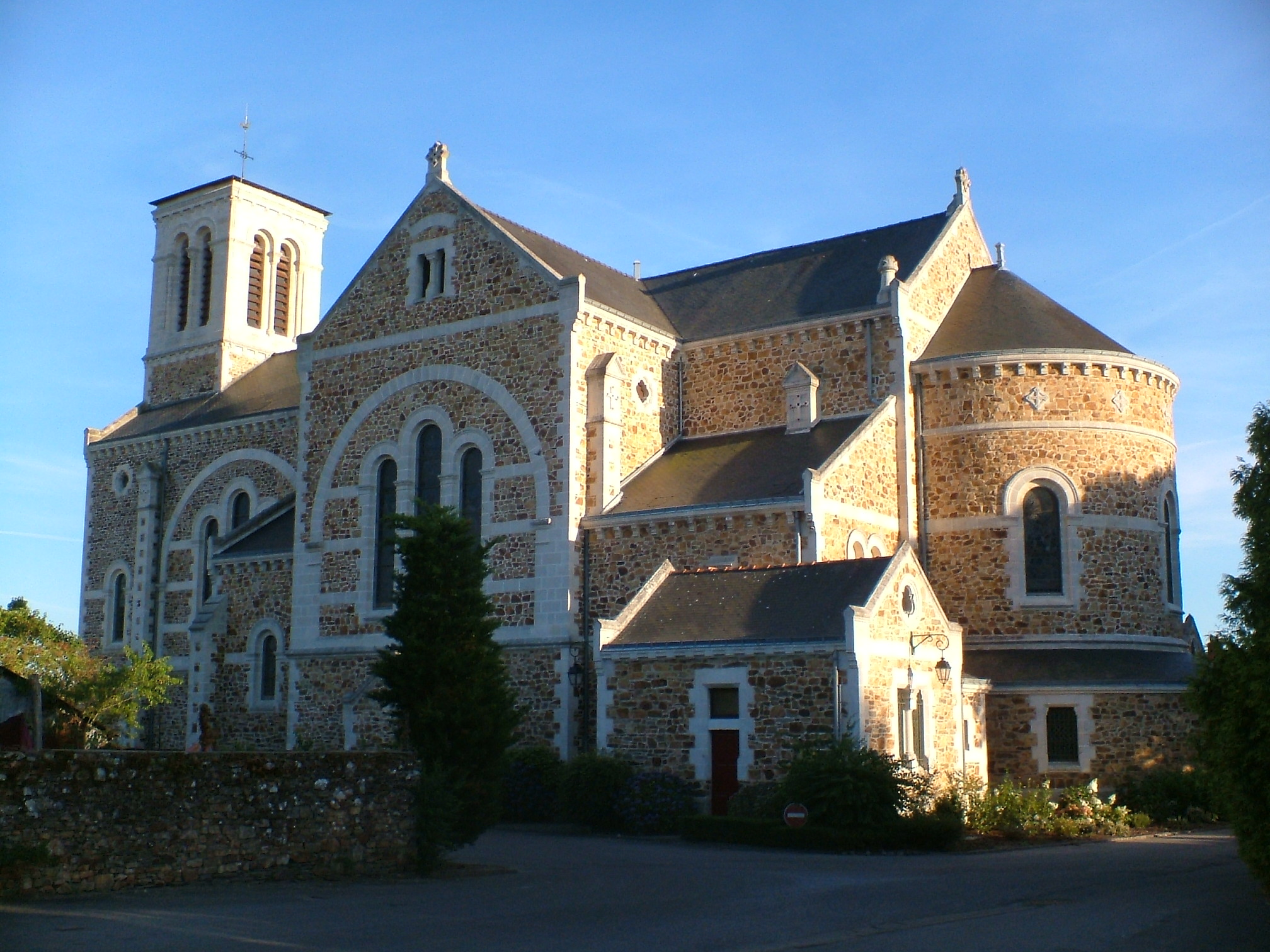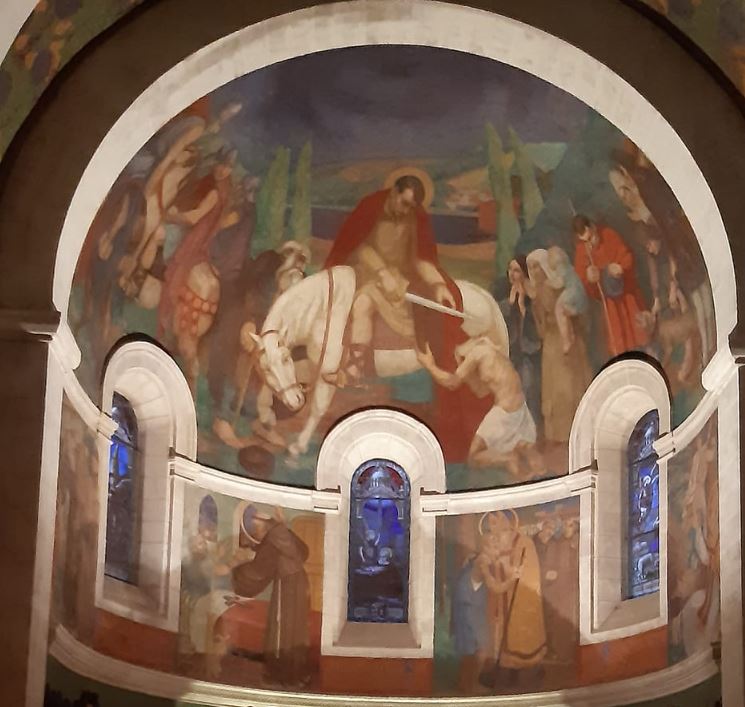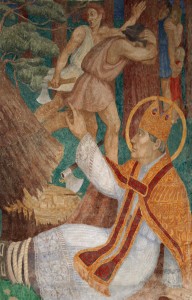L’actuelle église remplace un ancien édifice du XVe-XVIe siècle qui se trouvait à la place du monument aux morts. Elle a été construite en 1895-1896 par l’architecte René Ménard au lieu de l’ancien cimetière. Elle est achevée en 1922 par l’architecte Émile Libaudière. Le chœur a des peintures qui ont été réalisées par les frères Paul et Albert Lemasson, en 1925, puis complétées en 1932, avec, entre autre, la légende de saint Martin.
L’église abrite également deux bannières du XIXe siècle figurant saint Martin en évêque, un bas-relief présentant le songe de saint Martin et un reliquaire de la fin du XIXe – début XXe siècle.
L’église est inscrite aux Monuments historiques le 8 décembre 2008 PA44000042
Le chœur de l’église abrite une série de fresques figurant la légende de saint Martin. Elles ont été réalisées par Paul et Albert Lemasson de la fin juin à la fin août 1926. Elles figurent une charité de saint Martin, saint Martin demandant le baptême, saint Martin embrassant un lépreux, saint Martin ressuscitant un catéchumène et le miracle du pin abattu.
La charité de saint Martin est peinte sur la voûte. Saint Martin est nimbé, à cheval, vêtu d’un manteau rouge qu’il coupe avec son épée. Le mendiant est à demi-nu, porte une barbe blanche, agenouillé devant saint Martin, et tient le manteau entre ses mains. Deux femmes dont une tient un enfant se tiennent à droite de la scène, un homme âgé, avec une barbe blanche et appuyé sur une canne, se tient à gauche. Tous regardent le geste de saint Martin. Un soldat romain se détourne.
En-dessous de la charité sont peints quatre scènes de la vie de saint Martin.
Dans la scène de la demande de baptême, saint Martin est représenté enfant, nimbé, s’adressant à deux moines en robe de bure et tonsurés. D’autres moines regardent la scène.
Dans la scène du baiser au lépreux, saint Martin figure en évêque, mitré et nimbé, portant des vêtements dorés. Il embrasse un lépreux qui tient un bâton dans la main droite, habillé d’un vêtement bleu. Deux moines en arrière-plan regardent la scène.
Dans la scène où saint Martin ressuscite un catéchumène, saint Martin figure nimbé, vêtu d’une robe de bure, et est tonsuré. Il se tient devant le catéchumène qui est allongé dans un lit, les mains tendues vers saint Martin. Un crucifix se trouve sur le lit.
Dans la scène du miracle du pin abattu, saint Martin figure en évêque, nimbé et mitré. Il est allongé, la main droite tendue vers le pin, qui est coupé au niveau du tronc. En arrière-plan, des personnes prennent peur et se cachent.
The present church replaces an old building from the 15th-16th century which stood in the place of the war memorial. It was built in 1895-1896 by the architect René Ménard on the site of the old cemetery. It was completed in 1922 by the architect Émile Libaudière. The choir has paintings which were done by the brothers Paul and Albert Lemasson in 1925, and completed in 1932, with, among other things, the legend of Saint Martin.
The church also houses two 19th century banners depicting Saint Martin as a bishop, a bas-relief showing the dream of Saint Martin and a reliquary from the late 19th – early 20th century.
The church was listed as a Historic Monument on 8 December 2008 PA44000042
The choir of the church houses a series of frescoes depicting the legend of Saint Martin. They were painted by Paul and Albert Lemasson between the end of June and the end of August 1926. They depict the charity of Saint Martin, Saint Martin asking for baptism, Saint Martin embracing a leper, Saint Martin raising a catechumen and the miracle of the felled pine tree.
The charity of St Martin is painted on the vault. Saint Martin is nimbed, on horseback, wearing a red cloak which he cuts with his sword. The beggar is half-naked, with a white beard, kneeling before Saint Martin and holding the cloak in his hands. Two women, one of whom is holding a child, stand to the right of the scene, an elderly man with a white beard and a cane stands to the left. All are looking at St. Martin’s gesture. A Roman soldier turns away.
Below the charity are four scenes from the life of Saint Martin.
In the scene of the request for baptism, St Martin is depicted as a child, wearing a nimbus, addressing two monks in robes and tonsured. Other monks are watching the scene.
In the scene of the kissing of the leper, St Martin is shown as a bishop, mitred and nimbed, wearing golden vestments. He kisses a leper who is holding a stick in his right hand, dressed in a blue robe. Two monks in the background look on.
In the scene in which St. Martin is raising a catechumen, St. Martin appears nimbed, dressed in a robe, and is tonsured. He stands before the catechumen, who is lying in a bed with his hands outstretched towards Saint Martin. A crucifix is on the bed.
In the scene of the miracle of the felled pine tree, St Martin is shown as a bishop, nimbed and mitred. He is lying with his right hand outstretched towards the pine tree, which is cut off at the trunk. In the background, people are frightened and hide.

 "/>
"/>






